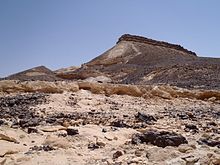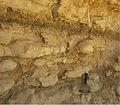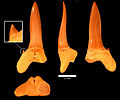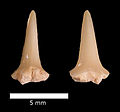- Menuha Formation
-
Menuha Formation
Stratigraphic range: Upper Cretaceous (Santonian)
Menuha Formation exposed in Makhtesh Ramon.Type Sedimentary Unit of Mount Scopus Group Underlies Mishash Formation Overlies Zihor Formation Thickness 14 to 50 m Lithology Primary chalk, marly chalk Other conglomeratic chalk, limestone Location Region Makhtesh Ramon, Negev desert Country Israel Extent Israel The Menuha Formation is the name given to an Upper Cretaceous (Santonian) chalk, marly chalk and conglomeratic chalk unit exposed throughout the Makhtesh Ramon region of southern Israel and parts of northern Israel (Avni, 1991).
Stratigraphy and paleoenvironment
The Menuha Formation records the earliest occurrence of the structural activity that formed the eroded anticline that is Makhtesh Ramon (Avni, 1993). It consists of white and yellow/brown chalk that is often glauconitic and sometimes conglomeratic or marly. The Menuha Formation likely represents a temperate to subtropical, outer continental shelf or middle slope environment. This is based on the occurrences of several shark and fish teeth, oysters, trace fossils, phosphatic peloids, and planktic/benthic foraminiferans. The isolated teeth represent at least ten different species:
- Cretalamna appendiculata
- Cretoxyrhina mantelli
- Squalicorax falcatus?
- Squalicorax kaupi
- Scapanorhynchus rapax
- Scapanorhynchus raphiodon?
- Carcharias samhammeri
- Carcharias holmdelensis
- Hadrodus priscus
- Micropycnodon kansasensis?
In order to sustain such a shark population, this environment would have also included plesiosaurs, ichthyodectids, mosasaurs, shrimp, and squid.
References
- Avni, Y. (1991). "The geology, paleogeography and landscape evolution in the central Negev Highlands and the western Ramon structure". Geological Survey of Israel, Report GSI/6/91: 153 p..
- Avni, Y. (1993). "The structural and landscape evolution of the western Ramon structure". Israel Journal of Earth Sciences 42: 177–188.
Categories:- Geologic formations
- Geology of Israel
- Geologic formation stubs
Wikimedia Foundation. 2010.













